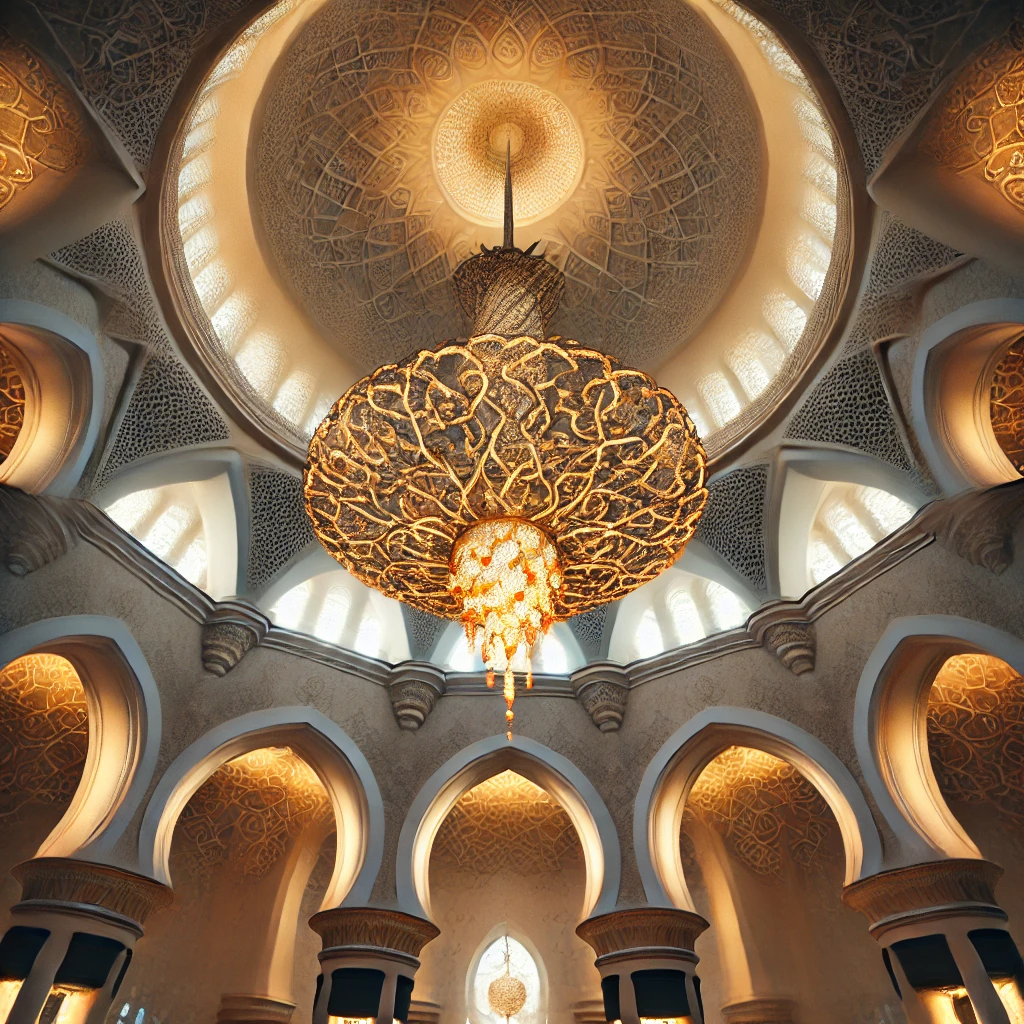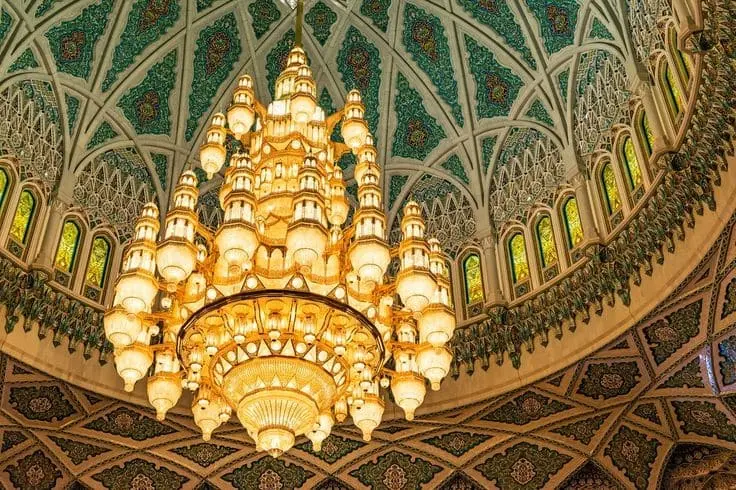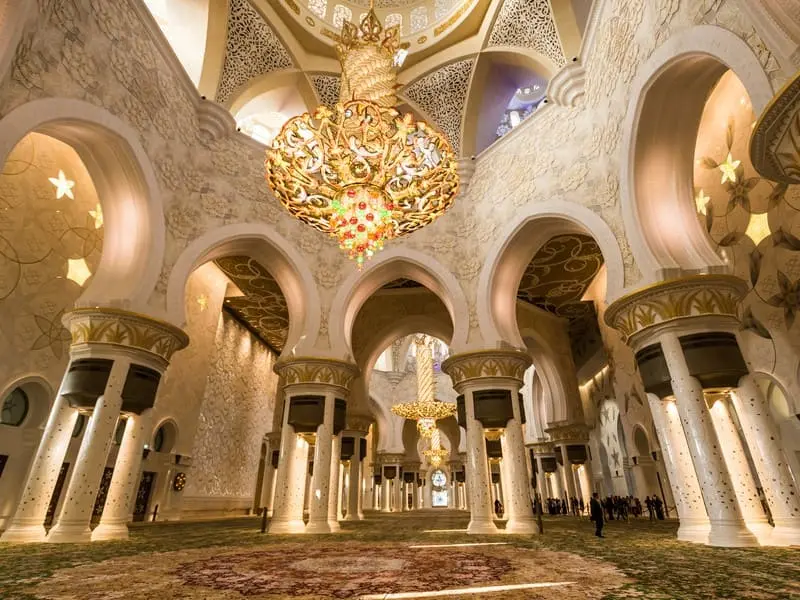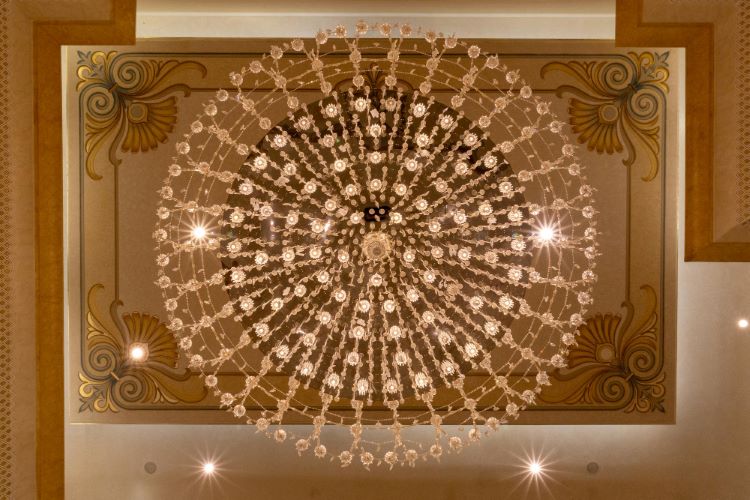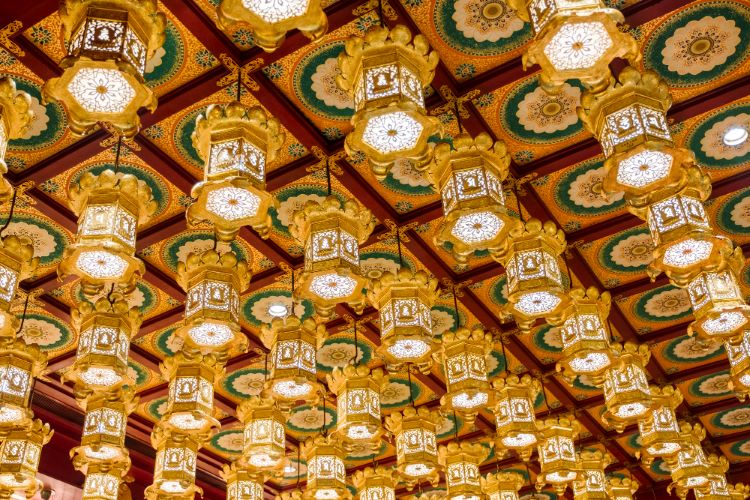Have you ever considered why Dome Algow and Mosque Chandeliers have remained timeless features of mosque architecture?
These features are not simply for decorative purposes; they play an essential role in the spatial flow and spiritual character of Islamic architecture. The Dome Algow provides an impressive, dimensional geometry, while the mosque chandeliers represents the pinnacle of illumination, beauty and light, shape and form, and woven together in as one.
In this article, we will engage with idea of how Dome Algow and Mosque Chandeliers influence spatial design, enrich the experience of worshippers, and express significant cultural and religious values – and the reason they remain definitive and revered features of Islamic architecture.
The Aesthetic and Symbolic Significance of Mosque Chandeliers
Mosque chandeliers are more than functional lighting fixtures; they carry deep symbolic and aesthetic value. Their design reflects Islamic artistic traditions, incorporating elements such as geometric patterns, arabesques, and calligraphy. Many chandeliers feature crystal, glass, or gold-plated metalwork, embodying opulence and grandeur.
Symbolism in Islamic Architecture
In Islamic architecture, light symbolizes divine presence, guidance, and knowledge. Chandeliers, as primary sources of artificial light, play a crucial role in manifesting this symbolism. A grand mosque chandelier hanging beneath a dome serves as a metaphor for celestial illumination, drawing the eyes upward and reinforcing the verticality of sacred spaces.
Types of Chandeliers for Mosque Interiors
Chandeliers in mosques vary in design, reflecting regional influences and architectural styles:
- Ottoman Chandeliers: Found in mosques like the Hagia Sophia in Istanbul, these chandeliers are typically circular or multi-tiered, suspended with long chains, creating a mesmerizing effect of floating light.
- Persian Chandeliers: Characterized by intricate glasswork and Persian motifs, these chandeliers often feature floral and arabesque patterns.
- Moorish Chandeliers: Common in Andalusian mosques, these designs incorporate brass and colored glass to create warm, ambient lighting.
- Modern Minimalist Chandeliers: Contemporary mosques may feature sleek, geometric chandeliers that integrate LED technology while maintaining traditional Islamic artistic principles.
Regardless of their stylistic differences, these chandeliers contribute to the visual hierarchy of mosque interiors, drawing attention to key architectural elements such as domes, mihrabs, and minbars.
The Functional Role of Mosque Chandeliers in Spatial Design
Beyond aesthetics, mosque chandeliers serve critical functional purposes, shaping the spatial experience in three main ways:
Enhancing Natural and Artificial Lighting
Mosques often rely on a combination of natural and artificial light. Domes, clerestory windows, and stained glass allow sunlight to filter in, while chandeliers complement this illumination.
A well-placed mosque chandelier ensures even distribution of light, preventing harsh shadows and maintaining a serene ambiance.
Larger mosques require multiple chandeliers to create layered lighting effects. The interplay of natural daylight and chandelier illumination transforms the prayer hall throughout the day, creating a dynamic spatial experience.
Defining Hierarchical Space
The positioning of chandeliers within a mosque highlights the hierarchy of space. The grandest chandeliers are typically placed beneath central domes or over prayer areas, reinforcing their significance. Smaller chandeliers or pendant lights may be used in secondary spaces such as corridors or ablution areas.
In vast prayer halls, chandeliers help delineate zones, subtly guiding worshippers’ movement and maintaining a sense of order. Their placement can emphasize architectural symmetry, enhancing the perception of balance and unity in mosque design.
Enhancing Acoustics and Atmosphere
The size and material of a mosque chandelier can influence the acoustics of the space. Large chandeliers with glass or crystal components can subtly diffuse sound, reducing echoes and improving speech intelligibility during prayers and sermons.
Additionally, the warm glow of chandeliers contributes to an atmosphere of tranquility and reverence, essential for spiritual contemplation.
The Interplay of Dome Algow and Mosque Chandeliers in Architecture
Mosque domes are central to spatial design, creating a sense of openness and grandeur. The relationship between domes and chandeliers is crucial in defining the mosque’s interior experience.
Visual Focus and Spatial Depth
A mosque chandelier suspended beneath a dome naturally draws the eye upward, emphasizing the verticality of the space. This effect enhances the perception of height, making the mosque feel more expansive and ethereal.
The chandelier acts as a mediator between the earthly realm and the divine, reinforcing the spiritual symbolism of the dome.
Light Reflection and Distribution
Domes often feature reflective surfaces, including gilded ceilings or mosaics, which amplify the light from chandeliers. This interaction creates a luminous effect, enhancing visibility while adding a sense of radiance to the interior.
In mosques like the Sheikh Zayed Grand Mosque in Abu Dhabi, chandeliers work in harmony with reflective domes to create a breathtaking interplay of light and shadow.
Structural Considerations
The weight and scale of a mosque chandelier must be carefully balanced to complement the dome’s structural integrity. Many grand chandeliers are suspended using reinforced systems to ensure stability.
In some cases, chandeliers are custom-designed to align with the curvature of the dome, maintaining architectural harmony.
Historical and Design Insights on Dome Algow and Mosque Chandeliers
For centuris Dome Algow and Mosque Chandeliers represent the pinnacle of Islamic architecture characterized by structural ingenuity and artistic form.
As quintessential features, they collectively provide lighting to mosques, but they also contribute to the mosques‘ spiritual and aesthetic experiencing, converting all bad interiors into spaces of majesty and worship.
- The Dome of the Rock (691 CE, Jerusalem): One of the earliest large-scale Islamic domes, spanning 20.4 meters (67 feet) in diameter, serving as an architectural precedent for later mosque domes.
- Süleymaniye Mosque (1557, Istanbul): Features a central dome measuring 27.25 meters (89 feet) in diameter, supported by half-domes to create an expansive prayer hall.
- Sheikh Zayed Grand Mosque Chandelier: Weighs approximately 12 tons, with a diameter of 10 meters (33 feet) and height of 15 meters (49 feet), making it one of the largest chandeliers in any mosque worldwide.
- Masjid al-Haram’s Largest Chandelier (Mecca): Measures 7.5 meters (24.6 feet) in diameter and features 1.2 million Swarovski crystals, symbolizing the grandeur of Islam’s holiest site.
- Sultan Qaboos Grand Mosque Chandelier (Oman): Contains 600,000 pieces of Swarovski crystal and weighs approximately 8.5 tons, combining traditional craftsmanship with modern lighting technology.
How to Choose the Right Dome Algow and Mosque Chandeliers
Choosing the right Dome Algow and Mosque Chandeliers is important to create the right effect and ambiance for the mosque’s interior. Here are some main considerations to support one’s choice;
- Scale and Proportion: One must verify that the size of the chandelier has an appropriate scale to the size of the Dome Algow and mosque space. Large domes have the capacity for large statements, and if the domes are smaller, the chandelier should follow the same proportional size with elegance.
- Lighting Quality and Quality of View: One should consider the type of light needed to the achieve spiritual atmosphere. The warm diffused lighting can provide a peaceful calm feel, whilst bright light can highlight and enhance other fine finished aspects of the walls and architecture.
- Fixture Design/Flow, Style and Manufacturing: The style of chandelier must match the architectural theme for that dome. Traditional chandeliers made of crystal would complement to the classic elegance feel, adding a modern design or custom chandelier would add a modern day luxurious feel to it.
- Material and Durability: Select high-quality materials that will ensure a long life span and easy maintenance. Durability is especially needed for chandeliers used within large high ceiling environments.
- Expert Consultation: Working with recognized professional lighting hosts, such as ESCO Lights, will provide you with the right opportunity to create something unique. Experts can advise you on design options, finishes, and installation methodologies that will enable Dome Algow and chandeliers to integrate flawlessly into a cohesive and meaningful spatial design.
Taking all of these components are carefully considered designers will select Dome Algow and Mosque Chandeliers that will not only light the space but enhance the space’s aesthetic, cultural and spiritual value.
Conclusion
The chandelier in a mosque is more than a light source; it defines the space, enhances the light, and adds to the grandeur of the dome. Dome Algow and Mosque Chandeliers have the power to enhance any mosque into a location of magnificence and spirituality while framing the experience of the worshippers, creating significance, and providing some connection to the divine.
You can bring this feeling of elegance to your space; see the collections at ESCO Lights for chandeliers that represent the sophistication of the historical experience blended with the luxury of the present day.

